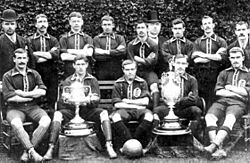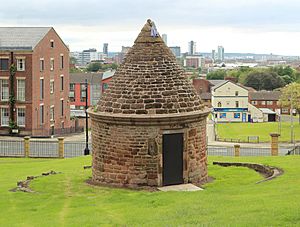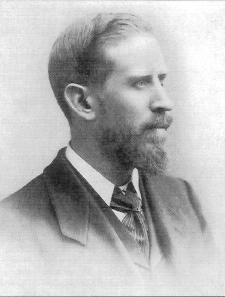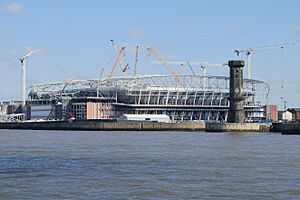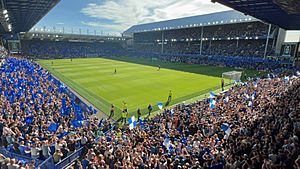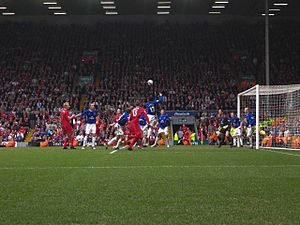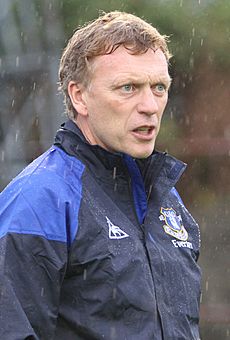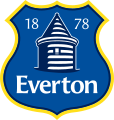Everton F.C. facts for kids
 |
|||
| Full name | Everton Football Club | ||
|---|---|---|---|
| Nickname(s) |
|
||
| Founded | 1878 | ||
| Ground | Hill Dickinson Stadium | ||
| Capacity | 52,769 | ||
| Owner | The Friedkin Group | ||
| Chairman | Dan Friedkin | ||
| Manager | David Moyes | ||
| League | Premier League | ||
| 2018–19 | Premier League, 8th of 20 | ||
|
|
|||
Everton Football Club is a professional football team from Liverpool, England. They play in the Premier League, which is the top football league in England.
Everton was started in 1878. They were one of the first teams to join the Football League in 1888. They also helped start the Premier League in 1992. This makes them one of only three clubs to be founding members of both leagues.
Everton is one of England's oldest and most successful clubs. They have won 24 major trophies. These include nine league titles, five FA Cups, and one European Cup Winners' Cup. They also won nine FA Charity Shields.
Their first league championship was in the 1890–91 season. After a quiet period following World War II, they had a strong comeback in the 1960s. More success came in the mid-1980s. During this time, Everton won two more league titles, another FA Cup, and the European Cup Winners' Cup in 1985. Their most recent major trophy was the FA Cup in 1995.
Everton has played in England's top football league for a very long time. They have been in the top division for a record 122 seasons. They only missed four top-flight seasons.
The team's traditional uniform is royal blue shirts with white shorts and socks. Everton started playing at Hill Dickinson Stadium for the 2025–26 season. Before that, they played at Goodison Park since 1892. They moved from their first home, Anfield, because of a disagreement over rent.
Everton fans are called "Evertonians," "Toffees," or "Blues." They have a big rivalry with their nearby club, Liverpool. This match is known as the Merseyside derby. In December 2024, American billionaire Dan Friedkin bought the club.
Contents
Club History
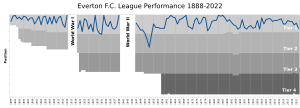
Everton started as St. Domingo's FC in 1878. Members of a church group wanted to play sports all year. They played cricket in summer. The club's first game was a 1–0 win. In November 1879, the club changed its name to Everton. This was so more people from the local area could join.
The club was a founding member of the Football League in 1888. They won their first league title in the 1890–91 season. That season started great with five wins in a row. Everton won the league by two points.
Everton played in four FA Cup finals before World War I. They won their first FA Cup in 1906 against Newcastle United. In the 1914–15 season, Everton won their second league title. Football was then stopped because of World War I.
In 1925, the club signed Dixie Dean. In 1927–28, Dean set a record by scoring 60 goals in one season. This record still stands today. He helped Everton win their third league championship. Two years later, Everton was moved down to the Second Division. But they quickly came back up, scoring many goals.
When they returned to the top league in 1931–32, Everton won their fourth league title. They also won their second FA Cup in 1933. This era ended in 1938–39 with a fifth league championship.
World War II stopped football again. When games started in 1946, the Everton team was not as strong. Many key players had left. Everton was moved down to the Second Division again in 1950–51. They came back up in 1953–54. Since then, they have stayed in the top league.
Everton's second successful period began in 1961 with manager Harry Catterick. In 1962–63, Everton won the League Championship. In 1966, they won the FA Cup. Two seasons later, in 1969–70, Everton won the League Championship again. During this time, Everton was the first English club to play in European competitions for five years in a row.
However, this success did not last. The team finished lower in the league in the following seasons. Managers after Harry Catterick did not win any trophies in the 1970s.
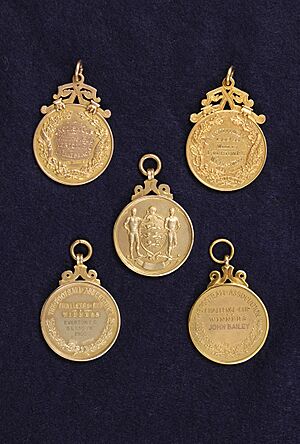
Howard Kendall became manager and led Everton to their most successful time. They won the FA Cup in 1984. They also won two league championships in 1984–85 and 1986–87. In Europe, they won their first and only European trophy, the European Cup Winners' Cup, in 1985. They beat German team Bayern Munich and Austrian club Rapid Vienna.
In 1985, Everton almost won three trophies. They won the League and Cup Winners' Cup. But they lost to Manchester United in the FA Cup final. The next season, they were second to Liverpool in both the League and FA Cup. But they won the League Championship again in 1986–87.
After the Heysel Stadium disaster, English clubs were banned from European football. This meant Everton could not compete for more European trophies. Many players from the winning team left. Howard Kendall also left.
Everton was a founding member of the Premier League in 1992. But they struggled to find the right manager. Former player Joe Royle took over in 1994. His first game was a 2–0 win against Liverpool. Royle helped Everton avoid being moved down. He also led them to win the FA Cup for the fifth time in 1995. This win allowed Everton to play in the Cup Winners' Cup again.
Progress continued in 1995–96 as the team finished sixth. Joe Royle resigned the next season. Walter Smith took over in 1998 but the team finished in the bottom half of the table for three years. He was sacked in March 2002. David Moyes then became manager and helped Everton finish safely in fifteenth place.
In 2002–03, Everton finished seventh, their highest since 1996. Under Moyes, Wayne Rooney became a star player. He was later sold to Manchester United for a club record fee. In 2004–05, Everton finished fourth. This meant they qualified for the UEFA Champions League qualifying round.
At the end of the 2012–13 season, Moyes left. Roberto Martínez became the new manager. Martínez led Everton to 5th place in his first season. This was their best points total in 27 years. The next season, they reached the last 16 of the 2014–15 UEFA Europa League. They also reached the semi-finals of two cups in 2015–16. Martínez was sacked after a poor run of games.
Ronald Koeman took over in 2016. In his first season, they qualified for the Europa League. But a bad start to the 2017–18 season led to Koeman being sacked. Sam Allardyce followed him but resigned due to fan unhappiness.
Marco Silva became manager in May 2018. He led Everton to finish 8th in his first season. But after a bad start to the next season, he was sacked in December 2019. Carlo Ancelotti then became manager. Ancelotti left in June 2021 to join Real Madrid.
Rafael Benítez was appointed next. He was only the second person to manage both Liverpool and Everton. He was dismissed in January 2022. Frank Lampard replaced him but was also dismissed in January 2023. Everton avoided being moved down from the league with a 1–0 win in their last game of the 2022–23 Premier League under new boss Sean Dyche.
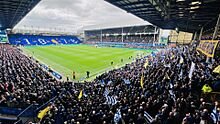
On 17 November 2023, the club received a 10-point deduction. This was for breaking the Premier League's financial rules. Everton had lost more money than allowed over three years. This was the biggest points deduction in Premier League history. Everton appealed this decision. On 24 January 2024, Everton faced more charges for financial rule breaches.
On 9 January 2025, Sean Dyche left his role. David Moyes returned to the club as manager after almost 12 years away.
Team Colours and Badge
|
|
| Everton's first home colours |
Everton's home colours are royal blue shirts, white shorts, and white socks. But in their early years, they wore different colours. They started with white, then blue and white stripes. To look more professional, they dyed their shirts black. A red sash was added to make them less gloomy.
When they moved to Goodison Park in 1892, their colours were salmon pink and dark blue stripes. They later changed to ruby shirts with blue trim. Royal blue shirts with white shorts were first used in the 1901–02 season. Fans protested when the team wore sky blue in 1906, so they went back to royal blue. Today, the home kit is royal blue shirts with white shorts and socks. They sometimes wear all blue to avoid colour clashes.
Everton's away colours used to be white shirts with black shorts. But from 1968, amber shirts and royal blue shorts became common. They have also used black, white, grey, and yellow away shirts.
In 1938, Everton's secretary, Theo Kelly, designed a club badge. He chose a picture of the Everton Lock-Up. This building is in the heart of the Everton area. It was built in 1787 and used to hold minor criminals. The Lock-Up is still there today.
Kelly added two laurel wreaths to the badge. Laurels are a sign of winners. The club motto, "Nil satis nisi optimum", was also added. This means "Nothing but the best is good enough." The badge first appeared on team shirts in 1978. It has changed a bit over time to the version used today.
In May 2013, the club released a new badge. Fans did not like it, with 91% saying no in a poll. A petition with over 22,000 signatures was created. The club apologized and promised a new badge for the 2014–15 season. They asked fans for their ideas. The latest badge was chosen by almost 80% of fans who voted. It started being used in July 2014.
Team Nicknames
Everton's most famous nickname is "The Toffees" or "The Toffeemen." This name came about after Everton moved to Goodison Park. One story says there was a toffee shop called Mother Noblett's near the stadium. It sold sweets like Everton Mints. This shop was also across from the Lock-Up on the club's badge. Today, a "Toffee Lady" walks around the pitch before games. She throws free Everton Mints to the crowd.
Everton has had other nicknames too. When they wore black uniforms, they were called "The Black Watch." Since 1901, they have been simply "The Blues." Their good style of play led to the nickname "The School of Science." The team that won the FA Cup in 1995 was known as "The Dogs of War." In 2002, manager David Moyes called Everton "The People's Club." This has become a semi-official nickname.
Stadiums
Early Playing Grounds
Everton first played in Stanley Park in 1879. In 1882, they moved to Priory Road. Then, in 1884, Everton became tenants at Anfield. This ground was owned by John Orrell, a friend of Everton member John Houlding. Houlding later bought Anfield and charged Everton rent. The rent kept going up, which the club thought was too much.
A disagreement between Houlding and the club led Everton to leave Anfield in 1892. They moved to a new ground, Goodison Park. Houlding tried to take over Everton's name and league spot. But The Football Association stopped him. Instead, Houlding started a new club, Liverpool F.C.
Goodison Park
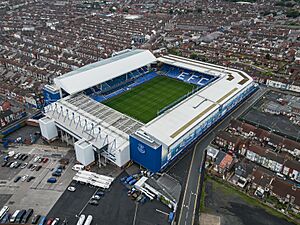
Goodison Park was the first major football stadium built in England. It opened in 1892. It has hosted more top-flight football games than any other ground in the UK. It was also the only English club ground to host a semi-final at the 1966 FIFA World Cup. Goodison Park was the first English ground to have under-soil heating. It was also the first to have two levels on all sides.
On match days, players walk out to the song "Johnny Todd." This tradition started in 1962. It's a traditional Liverpool children's song.
Starting from the 2025-26 season, Goodison Park will be the home of Everton's women's team. This makes it the largest dedicated women's football stadium in the UK.
Everton Stadium
Talks about a new Everton stadium began in 1996. Plans included a 60,000-seat stadium. Later, a 55,000-seat stadium was proposed. In 2004, Everton discussed sharing a stadium with Liverpool F.C. But they could not agree on costs.
Everton received permission to build the new Everton Stadium in July 2021. Construction started in August 2021. The stadium will hold 52,888 people. It is set to open for the start of the 2025–26 season. It will replace Goodison Park. On 16 May 2025, the stadium's first sponsor was announced as Hill Dickinson. The stadium is now called the Hill Dickinson Stadium.
Training Grounds
From 1966 to 2007, Everton trained at Bellefield. In 2007, the club moved to the Finch Farm training complex. This complex is used by both the men's and women's first teams. It is also used by the youth academy.
Finch Farm has 10 full-size grass pitches. One pitch is floodlit. There is also a synthetic pitch with lights. It has special areas for fitness and goalkeeper training. There is even a recreated Goodison Park pitch. The complex includes changing rooms, a fitness centre, and a hydrotherapy pool. It also has a media centre and a video lounge.
Fan Support
Everton has many fans. They had the eighth-highest average attendance in the Premier League in the 2008–09 season. Fans are known as Evertonians or Blues. Most of Everton's fans come from the North West of England. Many also travel from North Wales, Ireland, and Scotland. In Liverpool, fans of Everton and Liverpool F.C. live all over the city.
Everton also has fan clubs around the world. These are in places like North America, Singapore, and Australia. Paul McCartney is an Everton supporter. The official fan club is FOREVERTON. There are also fan magazines sold around Goodison Park on match days.
Everton fans often travel in large numbers to away games. They usually sell out all the tickets for away matches. In October 2009, 7,000 fans traveled to see Everton play Benfica. This was their biggest away crowd in Europe since the 1985 European Cup Winners' Cup Final.
Team Rivalries
Everton's biggest rivalry is with their neighbours, Liverpool. This match is called the Merseyside derby. The rivalry started because of a disagreement between Everton officials and the owners of Anfield. Everton then moved to Goodison Park, and Liverpool F.C. was formed in 1892.
Even though it's a fierce rivalry, it's often seen as more respectful than other local derbies. For example, red and blue scarves were linked between both stadiums after the Hillsborough disaster. The derby is usually a sold-out game. It's known as the "friendly derby" because fans from both teams often sit together. However, the games on the field can be very intense. The Merseyside derby has had more red cards than any other Premier League match.
The last Merseyside derby at Goodison Park was on 12 February 2025. It ended in a 2–2 draw.
Club Ownership and Money
Everton F.C. is a company. The club's board of directors owns most of the shares. In December 2024, American billionaire Dan Friedkin bought 94.1% of the club from Farhad Moshiri. Friedkin officially took over the club on December 19, 2024.
| Position | Name | Number of shares owned | Notes |
|---|---|---|---|
| Owner, Club Owner | Dan Friedkin | 127,031 | Bought 94.10% of Everton from Farhad Moshiri in December 2024. |
| Chairman | Marc Watts | – | – |
| Total amount of club owned by board members | 128,781 | ||
| Chief Executive Officer/Director | Angus Kinnear | – | Appointed in May 2024 from Leeds United |
The total shares owned by board members will stay at 128,781 until more information is available about the shares of the late Chairman Bill Kenwright CBE.
Shirt Sponsors and Kit Makers
Since the 2022–23 season, the main shirt sponsor has been the online betting company Stake.com. This was a club-record sponsorship deal. The Stake.com logo appears on the men's and women's playing shirts. It is also seen at Goodison Park and Finch Farm. The women's team can have their own shirt sponsor. Past sponsors include Cazoo, SportPesa, and Chang Beer. For the 2008–09 season, junior shirts were sold without the alcohol sponsor's name.
Everton's kit manufacturer from 2020-2024 was Hummel. Before that, Umbro made their kits many times. Other companies like Le Coq Sportif, Puma, and Nike have also made their kits. After Hummel's contract ended, the club signed a new deal with UK-based kit maker Castore on June 14, 2024.
The club has two official stores. One is near Goodison Park, called 'Everton One'. The other is in the Liverpool One shopping area, called 'Everton Two'.
| Period | Brand | Shirt Sponsor (chest) | Shirt Sponsor (sleeve) |
|---|---|---|---|
| 1974–1979 | Umbro | None | None |
| 1979–1983 | Hafnia | ||
| 1983–1985 | Le Coq Sportif | ||
| 1985–1986 | NEC | ||
| 1986–1995 | Umbro | ||
| 1995–1997 | Danka | ||
| 1997–2000 | one2one | ||
| 2000–2002 | Puma | ||
| 2002–2004 | Kejian | ||
| 2004–2009 | Umbro | Chang | |
| 2009–2012 | Le Coq Sportif | ||
| 2012–2014 | Nike | ||
| 2014–2017 | Umbro | ||
| 2017–2020 | SportPesa | Angry Birds | |
| 2020–2022 | Hummel | Cazoo | None |
| 2022–2023 | Stake.com | BOXT | |
| 2023–2024 | Kick | ||
| 2024–2025 | Castore | Christopher Ward |
Financial Rules
In November 2023, Everton received a 10-point deduction. This was because they had lost more money than allowed under the Premier League's financial rules. Clubs are allowed to lose a maximum amount over three years. Everton's losses were higher than this limit. This was the biggest points deduction in Premier League history. Everton said they were "shocked and disappointed" and planned to appeal the decision. On 24 January 2024, Everton faced more charges for breaking financial rules.
In the Community
Everton has a charity called Everton in the Community (EitC). This charity offers sports and other social activities for local people. It helps people with disabilities too. EitC works with other sports clubs in Europe.
Connections with Other Clubs
Everton has links with many other sports clubs. They work with Ballyoulster United in Ireland and the Canadian Ontario Soccer Association. They also have ties with the Thai Football Association. There is a competition in Thailand called the Chang-Everton Cup for schoolboys. The club also has a football academy in Cyprus. They have a partnership with American club Pittsburgh Riverhounds.
Everton is connected to the Chilean team Everton de Viña del Mar. This team was named after the English club. On 4 August 2010, the two Evertons played a friendly match at Goodison Park. This game was called the "Copa Hermandad" (Brotherhood Cup). Other Everton clubs exist in Uruguay, Argentina, and the U.S. state of California. There was also an Everton team in Trinidad and Tobago.
The club used to own a professional basketball team called the Everton Tigers. They played in the top British Basketball League. The team started in 2007 as part of the club's community program. They won the BBL Cup in 2009 and the play-offs in 2010. Everton stopped funding the team in 2010. The team then became the Mersey Tigers.
Players
First-team Squad
|
|
Players on Loan
|
Reserves and Academy Teams
Former Players
Club Captains
Since 1888, 48 players have been captain for Everton. The first captain was Nick Ross in the 1888-89 season. The longest-serving captain was Peter Farrell, who was captain for 9 years. He did not win any trophies as captain.
Kevin Ratcliffe was Everton's most successful captain. He led the team during their best period. He won 7 trophies, including two league titles and a Cup Winners' Cup. Everton's current captain is Séamus Coleman. He has been captain since 2019.

|
|
Player of the Season
Hall of Famers
Club Officials
Executive Team
| Position | Name |
|---|---|
| Chairman | |
| Executive Chairman | |
| Chief Executive Officer | |
| Director of Football | |
| Club ambassadors | |
Coaching Staff
| Position | Name |
|---|---|
| Manager | |
| Assistant Manager | |
| Goalkeeper Coach | |
| Set Piece Coach | |
| Physical Performance Coach | |
| Physical Performance Coach | |
| Head of Academy Coaching | |
| Under-21s Head Coach |
Famous Managers
The club's current manager is David Moyes. He returned for his second time at the club in January 2025. Before 1939, the team was chosen by the club secretary or a committee. The manager who stayed the longest was Harry Catterick. He was in charge for 594 matches from 1961 to 1973. The Everton manager who won the most trophies was Howard Kendall. He won two league championships, the 1984 FA Cup, the 1985 UEFA Cup Winners' Cup, and three FA Charity Shields.
Records and Statistics

Neville Southall holds the record for playing the most games for Everton. He played 751 first-team matches between 1981 and 1997. Brian Labone is second with 534 matches. The player who stayed with the club the longest was goalkeeper Ted Sagar. He played for 23 years, from 1929 to 1953. He played 495 games. Southall also held the record for most clean sheets in a season (15). But Tim Howard broke this record in the 2008–09 season with 17 clean sheets.
The club's top goalscorer is Dixie Dean, with 383 goals. The second-highest is Graeme Sharp with 159 goals. Dean still holds the English national record for most goals in a season with 60.
The record attendance for an Everton home match was 78,299. This was against Liverpool on 18 September 1948. Goodison Park is now an all-seater stadium and holds about 40,000 people. This means the attendance record will likely never be broken there.
Everton's record for a player bought was £45 million for Gylfi Sigurðsson in 2017. The most money Everton received for a player was £75 million for Romelu Lukaku. He was sold to Manchester United in the same year. This was then the largest transfer between two English clubs.
Everton holds the record for the most seasons in England's top league. They have played 122 out of 126 seasons. They were in Division 2 in 1930–31 and from 1951 to 1954. They are one of only six teams to have played in every Premier League season since it started in 1992. The others are Arsenal, Chelsea, Liverpool, Manchester United, and Tottenham Hotspur. Everton against Aston Villa is the most played match in England's top league. As of the 2024–25 season, they have played a record 214 league games.
Honours
| Type | Competition | Titles | Seasons |
|---|---|---|---|
| Domestic | First Division | 9 | 1890–91, 1914–15, 1927–28, 1931–32, 1938–39, 1962–63, 1969–70, 1984–85, 1986–87 |
| Second Division | 1 | 1930–31 | |
| FA Cup | 5 | 1905–06, 1932–33, 1965–66, 1983–84, 1994–95 | |
| FA Charity Shield | 9 | 1928, 1932, 1963, 1970, 1984, 1985, 1986 (shared), 1987, 1995 | |
| Continental | UEFA Cup Winners' Cup | 1 | 1984–85 |
Images for kids
See also
 In Spanish: Everton Football Club para niños
In Spanish: Everton Football Club para niños
- List of Everton F.C. managers
- List of Everton F.C. players
- List of Everton F.C. international players
- List of Everton F.C. records and statistics
- List of Everton F.C. seasons
- Everton F.C. in European football
- Everton W.F.C.


